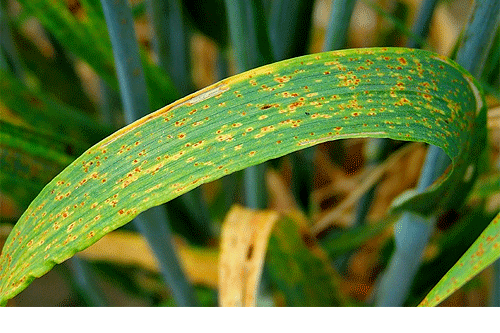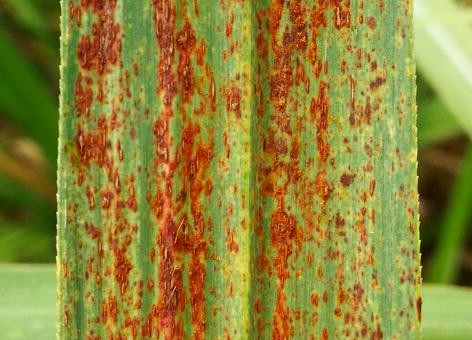

Sugar Cane Rust
After orange rust was first observed in 2007, it continued to increase in severity on susceptible cultivars throughout the summer growing season. Severe rust on newly emerged leaves in the upper canopy of CP80-1743 resulted in a greater number of "suckers" developing in the lower canopy. The effect was a lower sucrose content in juice extracted during commercial harvest of this cultivar. In 2008, orange rust developed first in plant crop fields of CP80-1743 because the plants were older. Symptoms were severe in February, and, except for abnormally dry periods in May, the disease continued to increase in distribution and severity. In 2009, Florida had a hard frost, and orange rust was slow to develop but increased in September 2009. Likewise, in 2010 and 2011, orange rust incidence was low during the summer but increased in September–October. In contrast, in 2012 the disease was already increasing on CP80-1743 in May and was severe during the summer months on all susceptible cultivars. During the 2013–2016 period, severe epidemics of orange rust occurred from May to August.
Prior to 2000, orange rust was thought to be confined to Southeast Asia and Australia, where it was considered a minor disease of sugarcane. However, in the year 2000, a severe orange rust epidemic occurred in Australia where the disease attacked the principle grown cultivar Q124. At that time, Q124 occupied approximately 45% of the total commercial area in the country and close to 90% of the crop in central Queensland. Yield losses were reported as high as 50%, and direct monetary losses were estimated at 200 million Australian dollars for the period 2000–2001 (Magarey et al. 2011). Losses in Florida were estimated at 10% overall but were as high as 43% on the highly susceptible cultivar CP80-1743.
SYMPTOMS
The typical symptom of orange rust is a pustule (uredinial lesion) on the underside of the leaf. The pustule is oval in shape, measures 2–10 mm × 1–3 mm, and is cinnamon to orange in color. Depending on cultivar resistance level, pustules may be rare (or non-existent) to extensive on all the leaves. Orange rust pustules are easier to distinguish from those of brown rust on the younger, upper leaves than on the older, lower leaves. The spores of orange rust are orange, whereas the spores of brown rust are brown, as their names imply . Numerous coalescing pustules cause premature tissue death on leaves (Figure 3).
CAUSAL AGENT
Orange rust is caused by the fungus Puccinia kuehnii. It is an obligate parasite that is only known to infect sugarcane. Although the disease was introduced recently in Florida, several observations suggest occurrence of variation in virulence of P. kuehnii. Cultivar CP89-2143 was considered resistant to the disease up to 2010–2011, but it showed severe symptoms of orange rust during the 2012 and 2013 crop seasons, suggesting that the pathogen population may be more diverse than first thought. Recent laboratory investigations support the existence of pathogenic variants of the orange rust pathogen in Florida (Sanjel et al. 2016). It is also worth noting that the extensive outbreak of orange rust on cultivar Q124 in Australia in 2000 was attributed to the development of a new race of P. kuehnii.
SPREAD OF THE DISEASE
Spores of the orange rust pathogen are extremely numerous on infected leaves of susceptible plants and are easily dispersed by wind and rain. Leaf wetness is required for successful infection. In Florida, normal durations of nightly dew periods are sufficient for infection. Orange rust appears to cause infection at higher temperatures than brown rust, because orange rust is present during the summer when brown rust infection is limited. Orange rust infection continues to occur in the warmer summer months of June through September, although excessively hot periods can limit its development. In contrast, brown rust development decreases during the warm summer months. Thus, orange rust spreads both within and between fields throughout most of the sugarcane cropping season.
How and from where the disease was introduced into the Western Hemisphere is not known. Transmission on seed cane is highly unlikely, because if seed cane could be contaminated with spores, the spores would then have to infect leaves in order to cause new infections. Similar to brown rust in the 1970s, it has been hypothesized that orange rust appeared in the Western Hemisphere as a result of transoceanic transport of urediniospores of P. kuehnii from Africa to the Americas.
PREVENTION AND CONTROL
The preferred method for controlling most rust diseases of plants is through the use of resistant cultivars. Unfortunately, many of the sugarcane cultivars that are commercially grown at the present time in Florida are not resistant to orange rust. Shifts to planting sugarcane clones resistant to orange rust will have to occur, and new sugarcane clones are now being screened for orange rust resistance within the CP sugarcane cultivar development program at Canal Point. This will ensure that resistant clones are released in the future. Presently, the number of resistant cultivars is limited and the supply of seed cane of resistant cultivars is insufficient for all new plantings. To complicate matters, new pathogenic races (strains of the rust pathogen) appear to arise as new varieties are expanded to large acreages. These may render resistance ineffective. With rust diseases being among the most economically important diseases of sugarcane, the development of durable resistance is of vital interest. It may be prudent for growers to diversify their cultivar holdings, allowing no cultivar to occupy more than 20%–25% of the total acreage to prevent catastrophic losses should a previously resistant cultivar become susceptible to a new rust pathogen variant or race. Additional control strategies—such as optimizing the planting date, modifying the crop's nutrition, and use of a disease prediction system—are currently being investigated.
Since the pathogen's introduction to the United States, a number of fungicides have been registered for use in managing orange rust, and additional registrations are anticipated. Currently, there are two strobilurin class fungicides (FRAC group 11) registered for use—pyraclostrobin and azoxystrobin. Two triazole class fungicides (FRAC group 3) have also been approved for use—metconazole and propiconazole—and a third class, the carboxamides (FRAC group 7), were more recently approved. Three pre-mixtures of the aforementioned classes are also registered. Of the three classes, the strobilurins have displayed the best efficacy and should serve as the basis for any chemical control program. However, to minimize the risk posed by fungicide resistance, no more than two sequential applications of this class can be made, and therefore they should be rotated with one of the triazole or carboxamide fungicides.
Fungicides may assist in reducing yield losses, and their effectiveness is determined by the number and frequency of applications. Economic benefits of fungicidal sprays have been obtained in commercial fields, but timing should be optimized to maximize returns. Due to the long duration of the cropping season, it is generally recommended that orange rust fungicide applications be made at 3- to 4-week intervals. The highest labeled rate should be used, particularly if applying at 4-week intervals, and a nonionic surfactant is recommended. In Florida, fungicide applications are recommended only on orange-rust-susceptible cultivars, beginning in the early summer months and extending into fall if conditions are favorable for disease persistence. Programs initiated in the fall (after considerable disease infection) have not proven to be effective or economically beneficial.

